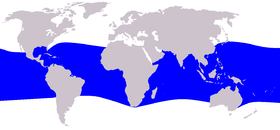Broad-billed dolphin
| Broad-billed dolphin | ||||||||||||
|---|---|---|---|---|---|---|---|---|---|---|---|---|

Broad-billed dolphin ( Peponocephala electra ) |
||||||||||||
| Systematics | ||||||||||||
|
||||||||||||
| Scientific name of the genus | ||||||||||||
| Peponocephala | ||||||||||||
| Nishiwaki & Norris , 1966 | ||||||||||||
| Scientific name of the species | ||||||||||||
| Peponocephala electra | ||||||||||||
| ( Gray , 1846) |
The broad-billed dolphin ( Peponocephala electra ) is the only species within the genus Peponocephala and belongs to the dolphins (Delphinidae). It can be found in all tropical waters around the world , but due to its preference for deeper regions, there are very few sightings.
features
When fully grown, the whale is around 2.1 to 2.7 meters long and weighs around 160 kilograms. The body is torpedo-shaped with a slender, pointed head, which gives the animal its scientific and English name. The muzzle is blunt. The mouth is surrounded by white, light gray or pink pseudo lips. The body is colored blue-black, dark gray or dark brown. The face area is darker, creating the impression of a face mask, and there is a darker, cape-like patch on the back. An inconspicuous, light gray, anchor-shaped spot lies on the chest, a light gray or off-white on the back abdomen. The flippers are long and pointed, the fin is high and sickle-shaped with a pointed end. In profile, the broad-billed dolphin differs from the small killer whale by having a less rounded head. The base of the tail is narrow. The fluke is wide with a slight indentation in the middle and clearly concave rear edges. The females have a narrower fluke than the males.
Way of life
Little is known about the broad-billed dolphin; most of the scientific data comes from studies of stranded specimens. The broad-billed dolphin often jumps out of the water in shallow jumps. The animals form large schools with mostly 100 to 500, occasionally over 1000 animals. Cuttlefish , squids and fish serve as food .
distribution
The broad-billed dolphin is found in all tropical and subtropical seas around the world . In the northern areas it occasionally penetrates the temperate waters, the northernmost sighting comes from the south coast of Ireland . However, it has the main distribution in the area between the northern and southern 20th parallel . Sightings mainly take place away from the continental shelves . The waters around Hawaii and in the Tanon Strait , between the islands of Negros and Cebu ( Philippines ), are among the places where a sighting is most likely.
Taxonomy
When it was first described in 1846, the species was assigned to the short-snouted dolphins (genus Lagenorhynchus ) by John Edward Gray , but in 1966 Masaharu Nishiwaki and Kenneth S. Norris placed it in a separate genus Peponocephala . Pepono is derived from the Latin name of the garden pumpkin ( Cucurbita pepo ) and is probably a mistranslation of the newcomers who chose the name after the common name in English 'Melon-headed Whale' (= "melon-headed whale") mistook the melon for the pumpkin. Hence the correct translation of the generic name would be "pumpkin-headed whale".
|
Phylogenetic systematics of the Delphinidae according to Horreo 2018
|
Genetic studies show the Breitschnabel dolphin as sister species of Zwerggrindwals ( Feresa attenuata ) and both together as Schwestertaxon to the two types of pilot whales ( Globicephala ) Together, these species with little Orca ( Pseudorca crassidens ) and the Risso ( Grampus griseus ) the subfamily Globicephalinae within the dolphins and are compared to the two species of the genus Orcaella .
Strandings
At the end of September 2019, around 200 broad-billed dolphins were stranded on a beach in Boa Vista .
supporting documents
- ↑ a b c José L. Horreo: New insights into the phylogenetic relationships among the oceanic dolphins (Cetacea: Delphinidae). Journal of Zoological Systematics and Evolutionary Research 57 (2), May 2019; Pp. 476-480. doi : 10.1111 / jzs.12255
- ↑ Mysterious dolphin deaths on the African west coast rtl.de, September 30, 2019, accessed October 12, 2019.
literature
- Mark Carwardine : Whales and Dolphins . Delius Klasing, Bielefeld 2008, ISBN 978-3-7688-2473-6 , p. 156-157 .
Web links
- Peponocephala electra in the endangered Red List species the IUCN 2006. Posted by: Cetacean Specialist Group, 1996. Retrieved on 12 May, 2006.
